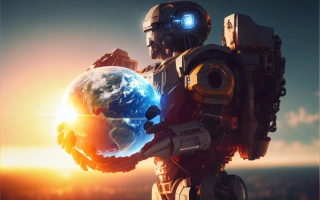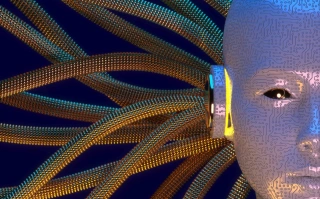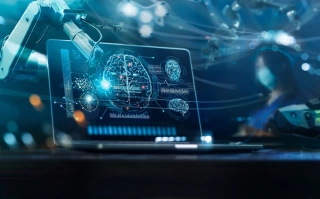Gartner analysts presented business trends that will be taken into account when making business and technology decisions over the next three years
Experts from the research and consulting company Gartner presented a study that describes the top ten strategic technology trends in 2024. Following these trends will improve business sustainability, maximize the value of data, attract and retain talent, achieve sustainable development goals, and stimulate growth and acceleration of digital business. Xu Techs tells what these trends are.
Technology Trends Map
Gartner presented a map that shows how each trend relates to one or more key business themes: protecting and preserving past and future investments, making the right decisions at the right time, and delivering value to a changing environment for both internal and external customers.
Tech trends map 2024 (Photo: gartner.com)
The map includes 10 trends: AI Trust, Risk and Security Management (AI TRiSM), Continuous Risk Management (CTEM), Sustainable Technologies, Platform Development, AI Development, Industry Cloud Platforms, Smart Applications, Generative AI Democratization, Advanced Connected labor and machine clients. Let’s take a closer look at them.
Investment protection
Gartner analysts note that the sustainable impact of technology investments is ensured by focused efforts, calculation of payback and foresight in their implementation. The following IT trends fall into this category:
AI Trust, Risk and Safety Management (AI TRiSM);
continuous risk management (CTEM);
industry cloud platforms;
sustainable technologies;
democratizing generative AI.
Managing AI Trust, Risk and Safety
Generative AI has generated widespread interest in AI pilot projects, but organizations often don’t consider the risks until AI models or applications are put into practice. A comprehensive AI trust, risk, and security management program proactively integrates governance and ensures AI systems are compliant, fair, reliable, and protects data privacy.
TRiSM for risk management offers model explainability and monitoring tools, ModelOps agile management, and AI security and privacy tools.
Gartner predicts that by 2026, the AI models of organizations that implement TRiSM will achieve 50% improvement in terms of business goals and user acceptance.
Continuous risk management
The Continuous Risk Management program independently identifies and prioritizes cyber threats to the business. It allows businesses to continuously and consistently assess the accessibility of its physical and digital assets to hackers, as well as their susceptibility to attack.
Step-by-step implementation of the STEM program (Photo: gartner.com)
Gartner believes that by 2026, organizations that prioritize security technology investments based on continuous risk management programs will be three times less likely to experience a breach.
Industry cloud platforms
Industry-specific cloud platforms are designed to address the specific needs of industry segments that are underserved by generic solutions. Such platforms combine the capabilities of software as well as platform and infrastructure as a service (IaaS). They are based on public cloud services, but offer industry players a more flexible way to manage workloads.
In a 2022 Gartner survey of North American and European enterprises, nearly 40% of respondents said they had already begun implementing industry cloud platforms, with another 15% piloting them. Analysts expect that by 2027, enterprises will use industry cloud platforms to accelerate more than 50% of their critical business initiatives. In the future, they will transform into ecosystem clouds where enterprises will be able to conduct business processes such as procurement, distribution, payment processing, and perhaps even present R&D and innovation.
Smart apps
Intelligent applications offer new experiences to customers, users, product owners and developers. Their implementation provides a link between continuous analytics and decision-making, and also provides significant opportunities through the implementation of chatbots and smart interfaces. All this increases automation and enables dynamic business transformation.
AI applications in business (Photo: gartner.com)
Gartner analysts predict that by 2026, 30% of new applications will use AI. Conventional insurance companies will implement AI to assess property damage risks, and auto insurers will implement AI to assess driver behavior.
Sustainable Technologies
AI models are trained using energy-intensive servers in data centers (DPCs), which increase carbon emissions. Data centers where AI is trained already account for about 2% of all US electricity consumption. A compromise might be to combine “AI for sustainability” with “AI sustainability.” Analysts believe that the following measures need to be taken to implement it:
implement composite AI that works like the human brain and uses knowledge graphs, cause-and-effect networks and other “symbolic” representations to more effectively solve a wide range of business problems;
monitor energy consumption during machine learning and stop it when the costs are no longer justified;
store model training data locally to reduce power consumption and increase data privacy;
reuse already trained models and introduce more energy-efficient equipment;
regulate AI workloads depending on region, time of day, weather conditions and other factors;
use clean energy in the data center and model the environmental impact and business benefits when developing an AI strategy.
Analysts predict that by 2027, 80% of CIOs will focus on performance metrics tied to the sustainability of their organization.
Unlocking the value of communities
Gartner analysts believe that in 2024, businesses need to tap into the creativity of the many communities creating applications and other solutions. Steps to this will include adopting industry technologies that meet the specific needs of the organization and professionals, developing a roadmap for non-experts, and working closely with business stakeholders to deliver software. The following IT trends correspond to this:
platform development;
development using artificial intelligence technologies;
industry cloud platforms;
smart applications;
sustainable technologies;
democratizing generative AI.
Platform development
Platform design improves the developer experience and productivity because they can work independently with automated processes and have their needs served by a dedicated team of engineers. At the same time, the end user receives the finished product faster, and development and implementation are cheaper. Gartner expects 80% of software organizations to have platform teams by 2026.
AI Development
Analysts note that software engineers can use AI for mission-critical activities throughout the software development lifecycle, from planning to testing. AI is already capable of writing code, translating it into different programming languages, modernizing applications and calculating their costs, developing application design, and much more.
AI capabilities in development (Photo: gartner.com)
According to analysts, by 2026 generative AI will significantly change 70% of the design and development processes of new applications.
Delivering Value
Analysts note that adapting business to changing customer requirements will improve the quality of service to stakeholders and increase revenue. This will be facilitated by algorithm-based approaches, as well as access to rapidly evolving digital tools. The following trends correspond to them:
machine clients;
an expanded connected workforce;
smart applications;
sustainable technologies;
democratizing generative AI.
Machine clients
Machine clients are devices with artificial intelligence that can potentially also act as consumers of services, for example acting as a voice assistant (ordering food, etc.). As the market for such devices grows, Gartner analysts advise companies to make information about products and services easily accessible to AI customers at any stage of the purchase. This will be facilitated by:
open access to API (hardware and software), as well as the introduction of anti-bot tools;
leveraging all digital touchpoints, including social media, mobile apps and chatbots, and creating a customer platform for simplified interactions and payments;
developing partnerships between sales, marketing, supply chain, IT and analytics departments that will allow us to consider different scenarios of consumer behavior and make the supply chain flexible enough to respond to unexpected demand trends;
training sales and service personnel to work with AI agents. Employees must understand the algorithms that determine customer purchasing behavior;
training staff to identify car buyers.
Analysts predict that by 2026, car customers will be able to independently choose from competing products the owner needs, and by 2036, they will be able to independently select different products, analyzing the owner’s needs.
Expanded Connected Workforce
Generative artificial intelligence will change the way companies organize jobs and distribute responsibilities. According to analysts, this challenge will be solved by generative micro-applications – a technology that will allow organizations to demonstrate the value of generative AI while minimizing business risks. They will act as a proxy between the user and a larger language model such as ChatGPT or Bard .
Gartner predicts that by 2026, 50% of office workers at Fortune 100 companies will be working with AI in some form, either to increase productivity or improve the quality of work. For example, when an author drafts a new study, a microapplication in a word processing program will activate a built-in library of prompts to prompt the AI for examples of supporting research and data, as well as examples of contradictory research.








